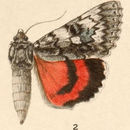en
names in breadcrumbs


Catocala semirelicta, the semirelict underwing, is a moth of the family Erebidae. The species was first described by Augustus Radcliffe Grote in 1874.[1] It is found in North America from Nevada, Colorado, Utah, California, and Nova Scotia south to Maine, west across Canada to British Columbia, and southward in the mountains.
The length of the forewings is about 30 mm. The wingspan is 65–75 mm.
Adults are on wing from July to September in one generation depending on the location. The larvae feed on Populus balsamifera, Populus tremuloides, and Salix species. There is probably one generation per year.
The latter is sometimes considered a distinct species.
Catocala semirelicta, the semirelict underwing, is a moth of the family Erebidae. The species was first described by Augustus Radcliffe Grote in 1874. It is found in North America from Nevada, Colorado, Utah, California, and Nova Scotia south to Maine, west across Canada to British Columbia, and southward in the mountains.
The length of the forewings is about 30 mm. The wingspan is 65–75 mm.
Adults are on wing from July to September in one generation depending on the location. The larvae feed on Populus balsamifera, Populus tremuloides, and Salix species. There is probably one generation per year.